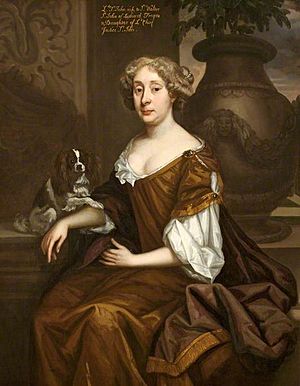Johanna St John facts for kids

Johanna St John (1631–1705) was an English gardener and expert in herbs. She was the oldest daughter of Oliver St John, a famous member of Parliament. Johanna later married Sir Walter St John, who was a distant relative. During her life, she created two special books. These books were filled with recipes for cooking, beauty, and medicines. She was also the grandmother of Henry St John, who became the first Viscount Bolingbroke.
Contents
Her Early Years
Johanna St John grew up during a time of big changes in England. This was the English Civil War. Her father, Oliver St John, was a strong supporter of Oliver Cromwell. He was a leading member of Parliament.
When Johanna was a baby, her mother, Johanna Altham, took her to a home in High Laver, Essex. This was the home of her mother's stepfather, Sir William Masham. Johanna was baptized there on January 27, 1631. In 1649, she married her distant cousin. They had thirteen children together.
Life at Lydiard House
Lydiard Park is a large country park in Lydiard Tregoze, England. It covers 260 acres. This park was later owned by Johanna St John's grandson, the Viscount of Bolingbroke. Johanna St John had a summer home there called Lydiard House.
Creating Her Recipe Books
We know a lot about Johanna's work from letters she wrote. These letters were to her steward, Thomas Hardyman. At Lydiard House, Johanna had many things she needed. She had food, herbs, and farm animals. These were the materials she used to make her recipe books.
Johanna used these materials for many purposes. She made food, but also distilled medicines. The letters show that Johanna did not make all the recipes herself. Instead, she gave "exact details" to a team. This team included distillers and people who gathered herbs. She also worked with other recipe-makers in London. For example, she worked with Sir Edward Spencer and Lady Manchester. They had remedies for sore eyes. She also worked with Sr. Philip Warwick, who had a remedy for cramps.
Interesting Recipes She Made
Johanna St John's recipe books included many different kinds of recipes. Some were for health, and others were for beauty.
Banister's Powder: A Historical Remedy
One recipe was called "Banister's powder." We are not sure exactly what it was for. However, its first three ingredients are interesting. They were unicorn horn, bezoar stone, and bones of stag heart. These ingredients suggest it was meant to treat poison. This recipe is important. It shows how people in the early modern period sometimes used magic in their remedies.
"To Make Hands White": A Beauty Secret
Many of Johanna's recipes were for curing sicknesses. But some were for beauty. Her recipe "To Make Hands White" is an example. She used a mix of herbs and seeds. This mix was to clean her hands and make them white. This was important for women of high social standing. Having pale skin showed that you were wealthy. It meant you did not have to work outside in the sun.

